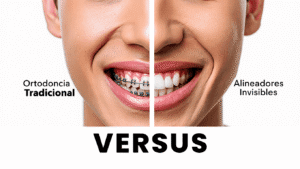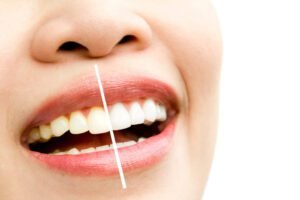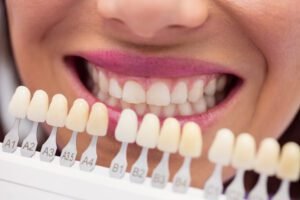At AM Dental Studio, we’re obsessed with making sure your prosthetics look natural, stay fresh, and never give you trouble. If you nail three things—hygiene, adhesive, and habits—you’ll have dentures that look amazing and, most importantly, feel comfortable. Here’s how we handle it in our clinic and what we recommend to our patients in Guadalajara and Zapopan.
1. Daily and weekly checklist for a prosthesis that looks and smells fresh
Step-by-step cleaning (quick and gentle)
- Brush the prosthesis with a soft brush (ideally one made for dentures) and a non-abrasive cleaner. Avoid regular toothpaste, as it can scratch the material.
- Cepilla la prótesis con un cepillo suave (mejor específico para prótesis) y un limpiador no abrasivo. Evita la pasta dental común porque puede rayar el material.
- Soak the prosthesis in a denture cleaning solution (effervescent tablets or a recommended solution). Follow the manufacturer’s timing instructions.
- Rinse with water and let it air-dry on a clean towel.
- Oral hygiene: even if you don’t have teeth, brush your gums, tongue, and palate with a soft brush or damp gauze.
AM Dental Studio Tip (experience 1): in check-ups, we’ve seen that patients who rinse after every meal and soak their dentures overnight show up with fewer stains and fresher breath. It’s the winning combo.
What not to use: no-go list
- No hot or boiling water: it warps the prosthesis.
- Avoid bleach and abrasives: they dull the surface, create micro-scratches, and trap plaque.
- Don’t use vinegar or baking soda carelessly: they can damage the material and affect retention.
- Don’t sleep with your prosthesis on (unless specifically indicated): your oral tissues need to breathe too.
Common mistakes we see in the clinic (experience 2): showing up with a “shiny” prosthesis from scrubbing with whitening toothpaste, or leaving it to “soak” in pure mouthwash. The result: dull surface, persistent odor, and irritated tissues. Better: a denture-specific cleaner + water.
Weekly checklist
- Check for pressure spots or red areas on the tissues.
- Look for stains (tea, coffee, tobacco) and, if they show up, increase soaking frequency.
- Check retention: if you notice new movement, schedule a check-up for adjustment or relining.
2. Stress-free adhesives: how much, how, and when to use them yes (and when not)
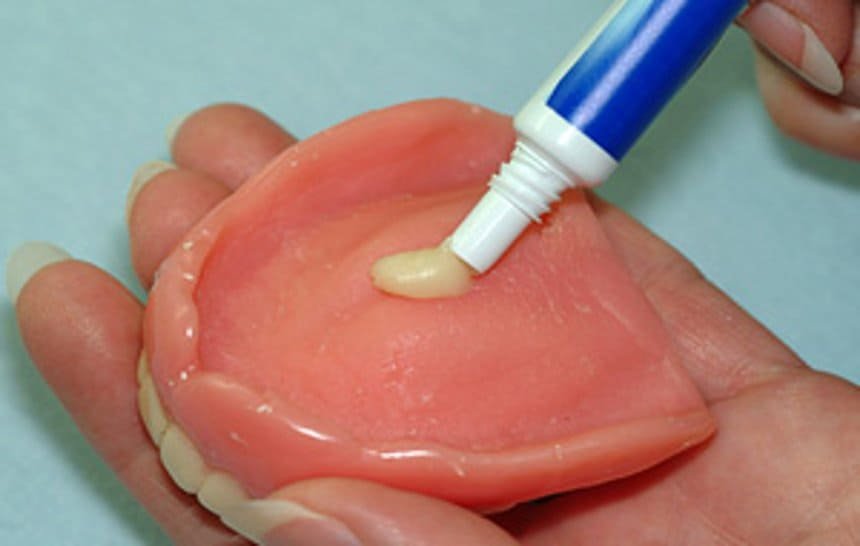
Used correctly, adhesive improves comfort and security. Used incorrectly, it masks problems (poor fit) and may cause irritation.
Cream vs. powder: practical differences
- Cream: more control over amount and sealing; ideal for full dentures.
- Powder: light to medium hold; useful for partials or as occasional support.
- Strips or cushions: convenient for hands with limited dexterity, but watch out for thickness if the base already fits snugly.
How to apply it (without overdoing it)
- Dry prosthesis.
- Small dots or thin lines on the base (less is more).
- Place it, bite down gently for a few seconds, and don’t eat until it sets.
- If it oozes over the edges, you’re using too much.
Common mistakes (and how to fix them)
- Using it to “make up for” a loose prosthesis → Solution: adjustment or relining, not extra adhesive.
- Layer upon layer “to make it last longer” → Solution: remove residue daily and reapply sparingly.
- Sleeping with adhesive → Solution: remove the prosthesis at night, clean the base and tissues.
How to remove residue without causing harm
- Remove the prosthesis and rinse with lukewarm water.
- Massage the base with a soft brush until the adhesive loosens.
- If residue remains on gums or palate, use damp gauze and patience.
What works for us (experience 3): when patients bring their adhesive, we do a “quantity test” in the chair: we apply the minimum effective amount, visually mark the support area, and teach them not to apply adhesive on the palate (to avoid altering the seal).
When to say “no” to adhesive
- Pain, ulcers, or pressure spots: adjustment comes first.
- Fractured or very worn base: consider relining or replacement.
- Persistent bad breath: check hygiene, fungal infection, and get a professional cleaning.
3. Zero stomatitis: habits and warning signs
Denture stomatitis (or sub-prosthetic stomatitis) is inflammation of the mucosa beneath the prosthesis, often linked to poor hygiene, continuous use, and sometimes Candida overgrowth.
Mucosal hygiene (tongue, palate, gums)
- Every night: remove the prosthesis and massage the mucosa with a soft brush or gauze.
- Use an alcohol-free rinse if you tolerate it; if there’s any suspicion of fungus, we’ll evaluate and prescribe treatment.
Avoid continuous use: why removing and soaking helps
- Decreases stagnant moisture and temperature that favor microorganisms.
- Reduces constant pressure on the mucosa → better microcirculation and less irritation.
Irritation, redness, pressure spots: when to ask for an adjustment
- If redness doesn’t improve within 48–72 hours after better hygiene and resting without the prosthesis, schedule a visit.
- If you notice burning or whitish patches that scrape off, it could be candidiasis: targeted treatment is needed.
AM Dental Studio protocol (experience 4): in cases of stomatitis, we create a pressure-point map, polish the base if needed, reinforce the prosthesis + mucosa hygiene routine, and schedule a follow-up. If the base has lost its fit, we prefer a reline rather than “more adhesive.”
4. Does it move or hurt? Adjustment, reline, or replacement: what the dentist decides
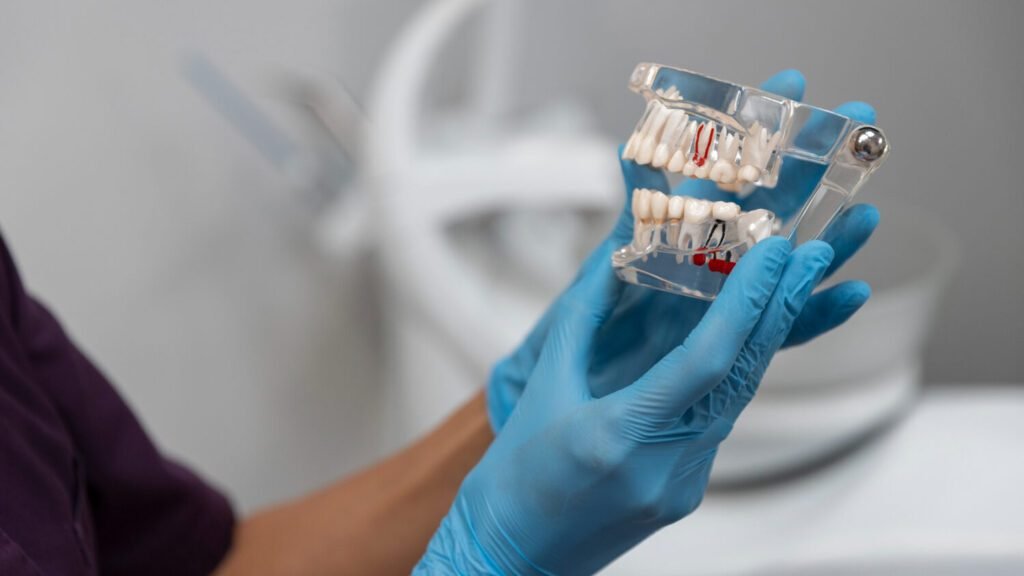
Dentures and your mouth change over time. Your jaw, gums, and bone remodel; a denture that fit perfectly yesterday may feel loose or cause rubbing today.
When is a reline needed?
- When the base has become too large due to gum/bone resorption.
- When retention depends “too much” on adhesive.
- If there are sharp edges or the posterior seal (in uppers) no longer works.
A reline fills the inner surface to readapt it to your current anatomy. It’s usually more affordable than making a new one and can instantly improve comfort.
Full dentures vs. implants and overdentures (retention and comfort)
If you’re looking for a big stability upgrade, we evaluate implants: from two implants with an overdenture (anchored retention) to hybrid solutions.
- More confidence when biting, less adhesive.
- Often improves speech and social confidence.
How we approach it (experience 5): for patients with very mobile lower dentures, we explain the option of two implants with an overdenture as a cost-effective solution. If the patient prefers to continue with a conventional denture, we reinforce adjustment + habits + minimal adhesive.
You may also be interested in: Full dentures, Dental implants.
5. Professional maintenance in Guadalajara/Zapopan

Check-up visits: frequency and what we review
We recommend a check-up every 6–12 months, sooner if you notice changes. We evaluate:
- Fit and pressure points with bite markings.
- Wear on prosthetic teeth and occlusal contact.
- Mucosa: color, lesions, signs of fungal infection.
- Habits: we review your routine and adjust it.
Professional denture cleanings and pressure point check
During the visit, we can remove stubborn plaque and polish the surface to make it smoother (less future buildup). If we find sharp edges, we smooth them out.
What we do every day (experience 6): at the end of each check-up, we hand over a personalized mini-routine (which cleaner, which brush, how much adhesive). That little note on the fridge cuts down on relapses.
Typical cases we see in the clinic and how we solve them
- “It moves when I bite into an apple” → We check the seal and base; if there’s space, reline.
- “Food gets stuck underneath” → Border adjustment + education on how to apply adhesive.
- “My palate burns” → Night rest + mucosa hygiene; if it persists, culture/treatment.
You may also be interested in: Dental cleaning, Services, Our specialists, Why choose us?.
Conclusion
Impeccable prosthetics = smart hygiene + measured adhesive use + mucosa-friendly habits. If something bothers you, don’t cover it up with more adhesive: we adjust or reline, and if you want top stability, we explore implants. At AM Dental Studio, we love seeing how your smile (and your daily life) transforms when your prosthesis just works.
Frequently Asked Questions about dentures, adhesives, and stomatitis
Should I sleep with my dentures?
Ideally, no. Remove them, soak them in a denture-specific cleaner, and clean your mucosa. You’ll rest better and reduce the risk of stomatitis.
Can I use regular toothpaste to brush them?
We prefer denture cleaners; many toothpastes are abrasive and leave the surface rough.
How often should I change my dentures?
It depends on wear and how your mouth changes, but many people need adjustments or a reline within 1–3 years and replacement around 5–7 years. We’ll evaluate this together at your check-up.
How do I know if I’m using too much adhesive cream?
If it oozes over the edges, you’ve overdone it. It should feel like a seal, not “glue everywhere.”
I have bad odor even though I clean them
Check your overnight soaking and make sure you’re not using bleach, alcohol, or hot water. If it persists, come in for a professional cleaning and mucosa check.


